Mist Blower
Rotary Head Sprayer Machine Mist Blower
DocumentsEquipped with a 35 HP water-cooled Lombardini (Italian) Diesel engine, it comes with a 500-liter chemical tank and a 50-meter hose with a high-efficiency spraying gun.
Capabilities:
✔ 30 µm ULV
✔ 90 µm Mist Blower
✔ 148 µm Garden Sprayer
(Can be used efficiently in three different application areas.)
Description
Description
Mist blower devices are effective spraying machines used to leave residues on surfaces by spraying at high density (large droplets). Compared to vehicle-mounted ULV machines, these devices spray larger droplets and thus consume more pesticide forumlation. Therefore, 500-liter formulation tanks are preferred for ideal use.
One of the most critical elements affecting these device’s performance is the radial fan structure. Large-diameter radial fans provide high air flow, effectively delivering large pesticide droplets to much farther distances. However, these fans require high torque and horsepower. The higher the motor power of mist blower devices, the better their performance and durability.
For this reason, our device is equipped with a 35 HP Italian-made Lombardini water-cooled diesel engine. The water cooling system prevents the engine from overheating even during intensive long hours use ensuring long-lasting and uninterrupted operation. Especially under working conditions reaching 50°C in summer, water-cooled diesel engines are much more reliable and durable compared to gasoline and air-cooled engines.
In the market, mist blower devices equipped with 18 HP or 23 HP gasoline, air-cooled engines are sold to reduce costs. However, gasoline and air-cooled engines tend to overheat quickly in mist blower machines that require high torque power, causing breakdowns and interrupting spraying activities. Therefore, water-cooled engines should definitely be preferred when purchasing a mist blower device.
This device is a versatile combined machine capable of operating according to ULV (30–50 µm), Mist (50–100 µm), and Garden Sprayer (100–300 µm) criteria, capable of both residual and contact-effective spraying. It is generally preferred for controlling house flies, larvae, and for disinfection. For controlling mosquitoes and smaller pests, cold fogging machines should be preferred instead of mist blower devices. As a rule of thumb, spraying must always be done with droplet sizes suitable for the target pest’s body size. The World Health Organization (WHO) standard for mosquito control is a droplet size of up to 20 µm.
Advantages;
✔ Equipped with an automatic nozzle feature, it can be rotated to the desired position via joystick. It has 360° left-right and 270° up-down rotation angles.
✔ Powered by a 35 HP (Italian-made Lombardini) diesel engine, with a 30-liter fuel tank capacity.
✔ Runs on diesel fuel with an average consumption of 1.5 liters/hour, making it extremely economical. The 30-liter fuel tank allows up to 20 hours of uninterrupted operation per fill. This makes it significantly more cost-effective compared to gasoline-engine counterparts that consume about 4.5 liters/hour.
✔ Due to its water-cooled radiator system, it is much more durable compared to air-cooled gasoline engines. During hot summer days, engine body cracking due to overheating is common in air-cooled engines, but there is no such risk in water-cooled engines.
✔ Offers long-lasting spraying capability with a 500-liter formulation tank.
✔ With an air speed of 105 m/s, the effective range is 35 meters in closed indoors as per test reports (in open areas with light breeze, it can reach to even much farther distances).
✔ Equipped with a total of 16 nozzles: 8 mist nozzles (spraying droplets approximately 90 µm in diameter), and 8 ULV nozzles (spraying droplets approximately 30 µm in diameter.)
✔ Includes a 50-meter long high-pressure resistant hose, and a professional spraying gun. The spraying gun has both long and short-range spray options.
✔ Chassis dimensions are suitable for all double-cabin vehicles.
✔ The machine has a 2-year warranty against manufacturing defects and a 10-year spare parts availability and paid service guarantee.
✔ Licensed by the Turkish Ministry of Agriculture and Forestry.
✔ Has a full laboratory test report.
Frequently Asked Questions ;
What should be considered when purchasing a spraying machine?
When purchasing a spraying machine, the primary criterion is the uninterrupted continuation of periodic spraying activities. For example, mosquito control is generally carried out in 8-day cycles, and during this period, daily spraying must be done regularly considering the larval stage. Since the exact timing of larval deposition from previous mosquitoes cannot be known, the entire population is controlled by daily spraying for the first 8 days. Then, control is maintained with repeated periodic spraying every 8 days. This approach ensures significant savings in biocidal chemical consumption, effectively controlling the entire population.
However, if the spraying machine frequently breaks down, this routine is disrupted, and spraying activities must be restarted daily from scratch. This causes significant losses in both time and chemical costs.
Therefore, when choosing a spraying machine, instead of focusing solely on price-performance ratio; robust, durable, low-risk of break, simple, and purpose-appropriate machines should be preferred. Additionally, purchasing from manufacturers with a proven track record of easily and promptly supplying spare parts and providing after-sales support will be far more efficient in the long run.
In biocidal control, spraying machines are typically purchased once and used for about 10 years. However, biocidal chemicals must be regularly supplied every season for many years. Therefore, the correct equipment choice directly impacts chemical costs in the long term. To save on chemical use and conduct effective control, machines that can spray chemicals at the micron size most suitable for the target pest, have minimal risk of breakdown, and are made with quality components should be preferred. Such machines provide significant savings in labor, time, and chemical consumption, yielding successful biocidal control results in the long term.
What should be the droplet size according to the target pest?
For the control of small flying insects like mosquitoes, the World Health Organization (WHO) has set a standard that the diameter of particles sprayed using the cold fogging method should be at most 20 microns (µm). The main purpose of this approach is to prolong the suspension time of sprayed droplets in the air, to increase their drift distance, and enhance the likelihood of effective biocidal particles reaching the target pests through contact.
For controlling black flies and other medium-sized insects, the WHO recommends using droplets of 30 microns (µm) in diameter via the ultra-low volume (ULV) spraying method. This method ensures the appropriate dosage of insecticide reaching the target flies effectively and eliminating medium size insects.
In the case of large pests such as locusts, ticks, and stink bugs, sprayed particle diameters should range between 50-100 microns (µm) using the Mist Blower method. This allows the application of biocidal chemicals in sufficient doses by matching the droplet size to the pest’s physical size, producing effective results. There are two main reasons for preferring droplet sizes of 50-100 microns (µm) in Mist Blower applications:
- ✔ Larger droplets are needed to effectively neutralize larger sized insects,
- ✔ In contact or systemic based spraying activity, to prevent the excessive drift of droplets in the wind. With Mist Blower method, insecticide can travel up to approximately 30 meters and settles within 90 seconds; reaching the ground as large droplets. Thus, even if a month passes after application, insects consuming insecticide residues on the ground are eliminated through residual effects.
This method is ideal for source control of large pests such as larvae, ticks, and cockroaches found in parks, gardens, garbage areas, water channels, and residential surroundings.
For the control of larvae, bacteria, and parasites, the Garden Sprayer method, which uses droplet sizes between 100-300 microns (µm), and systemic (residual) insecticides should be preferred. The machine is equipped with a 50-meter hose gun, allowing both short and long-range spraying. This enables effective spraying and disinfection applications in various areas and conditions. When the garden sprayer mode is activated, sprayed droplet diameters range between 100 and 300 microns. This feature offers a wide application scope, from systemic fly control in slaughterhouses to larval control in water paddles. It is also successfully used in disinfecting animal habitats from viruses and parasites, and effectively sanitizing garbage containers.
For successful and effective biocidal control, selecting appropriate particle sizes according to the pest species and strictly adhering to the application criteria set by the World Health Organization is essential. The WHO guide titled “A practitioner’s guide” provides detailed spraying criteria. Consulting expert specialists also contributes to successful biocidal control.
Incorrect micron sizes and non-compliant applications lead to failure in pest control, unnecessary loss of time, and wasted chemicals.
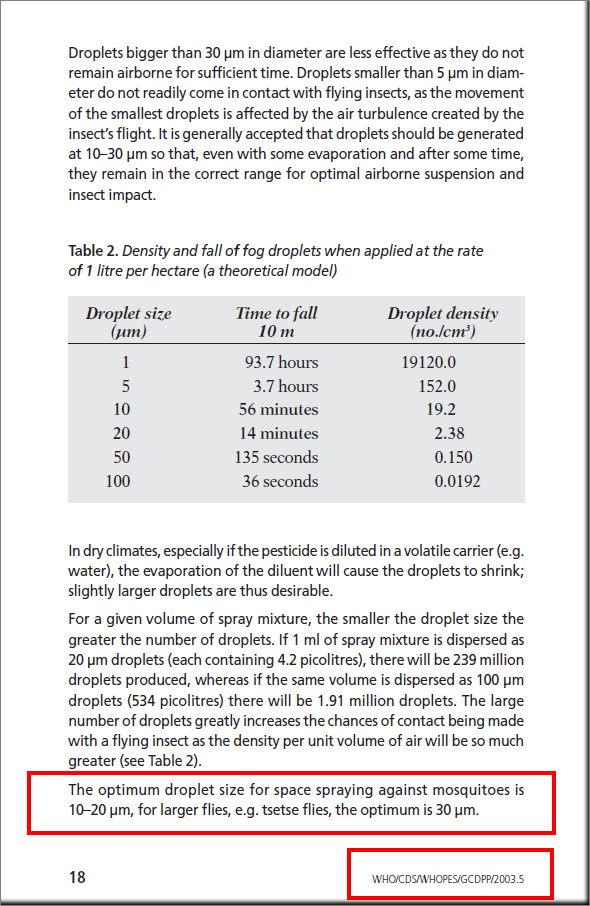
How should biocidal control be conducted?
Wind direction, wind speed, air temperature, high pressure, low pressure, and other atmospheric conditions directly affect spraying activities. In this context, detailed spraying criteria can be found in the World Health Organization (WHO) guide titled “A practitioner’s guide.” Additionally, consulting expert specialists in the field will ensure successful biocidal control.
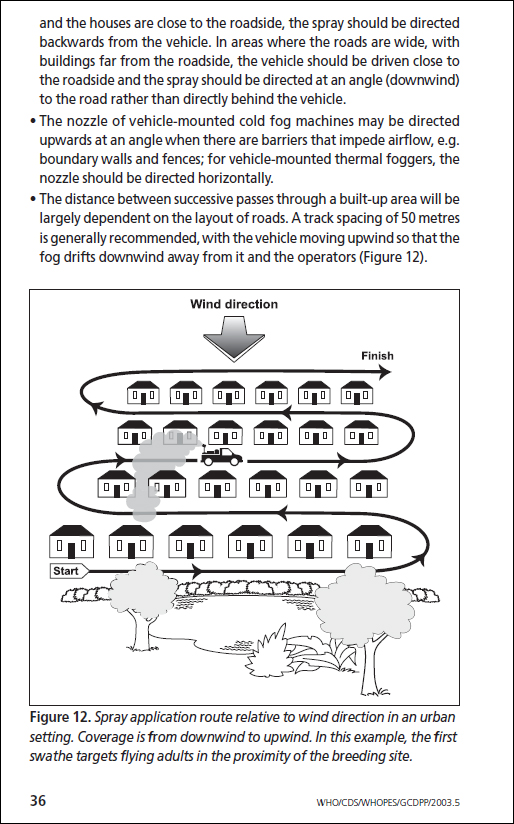
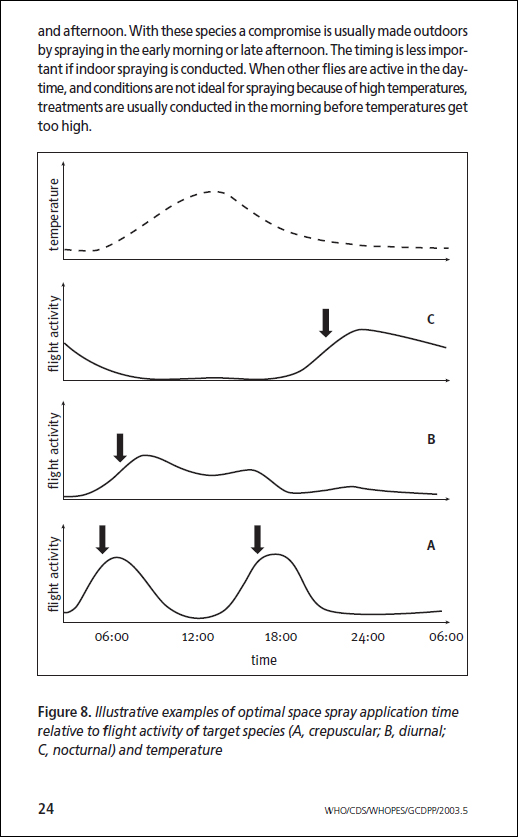
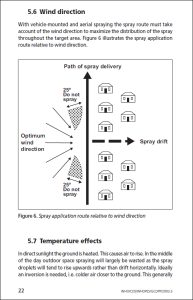

What is the criterion for cold fogging?
The cold fogging method is defined by the World Health Organization with a droplet size range of 0-30 microns (µm). In this method, the chemical substance in liquid form is sprayed as droplets sized 0-30 microns (µm). It is called “cold” because the process involves spraying as fog without using heat, by exposing the liquid to high air flow through a vortical type nozzle.
What is the ULV criterion?
The U.L.V. (Ultra Low Volume) method is defined by the World Health Organization with a droplet size range of 30-50 microns (µm). In this method, the chemical substance in liquid form is sprayed as droplets sized 30-50 microns (µm). The liquid is sprayed at low volume without using heat, by exposing it to high air flow through a vortical type nozzle. The term Ultra Low Volume has been adopted in the literature as “low volume spraying.”
What is the Mist Blower criterion?
The Mist Blower method is defined by the World Health Organization with a droplet size range of 50-100 microns (µm). In this method, the chemical substance in liquid form is sprayed as droplets sized 50-100 microns (µm). The liquid is sprayed at high volume without using heat. The term Mist Blower has been adopted in the literature as “high volume spraying.”
What is the Garden Sprayer criterion?
The Garden Sprayer method is defined by the World Health Organization with a droplet size range of 100-300 microns (µm). In this method, the chemical substance in liquid form is sprayed as droplets sized 100-300 microns (µm). The liquid is sprayed at high volume without using heat. The term Garden Sprayer has been adopted in the literature as “handgun spraying.”
What is the Thermal Fogging criterion?
The Thermal Fogging method is defined by the World Health Organization with a droplet size range of 1-100 microns (µm). In this method, the chemical substance in liquid form is sprayed as droplets sized 1-100 microns (µm). The liquid chemical is vaporized at a high temperature (400°C) and then sprayed as a dense fog (aerosol) cloud when it comes into contact with cold air. The sprayed particles are not transparent like in water-based spraying but appear as dense white smoke. The thermal fogging method does not burn the chemical or reduce its effectiveness. On the contrary, it provides an application that is 12 times more effective and efficient compared to water-based spraying. But because it obstructs visibility in traffic, its use on highways requires permission from local authorities. However, it is not subject to permission in private properties, rural areas, and residential neighborhoods. The term Thermal Fogging is known in the literature as “oil-based spraying.”
Technical Information
Additional information
| Engine | 35 Hp Lombardini, 1372 cm³, diesel, 4 cylinders, 4 stroke, water cooled, electric started |
|---|---|
| Pump | 3 Diaphragms, 40 bar, 50 L/min, 550 rpm (Comet APS51, made in Italy) |
| Pressure Regulator | Anodized aluminium, high pressure resistant (Comet HPR2, made in Italy) |
| Connection Type | V belt with hollow shaft gearbox |
| Nozzle | 8 ulv nozzles, 8 mist nozzles, (Total 16 pcs nozzles) |
| Spray Droplet Sizes | 30 µm for ulv, 90 µm for mist, 148 µm for hydraulic sprayer sizes in test report. (Adjustable) |
| Chemical Tank | 500 L, HDPE |
| Cleaning Tank | 30 L, HDPE, consumption 50 L/min |
| Diesel Fuel Tank | 30 L, HDPE, approx. consumption 1.5 L/h |
| ULV Consumption | 1.4~2.5 L/min (Adjustable) |
| Mist Consumption | 2.6~4.3 L/min (Adjustable) |
| Hydraulic Sprayer Cons. | 2.1~3.0 L/min (with 1.8 mm orifice), 4.0~5.9 L/min (with 2.5 mm orifice) |
| Remote Control | 6 m cable, engine start/stop, nozzle control joystick, mist spraying on/off, ULV spraying |
| Air Velocity At Nozzle | 105 m/s |
| Noise Level | 76 dB(A) |
| Battery Type | 12 V, 60 Ah |
| Weight | Empty 495 Kg, Full 1.055 Kg, Shipping weight 830 Kg |
| Dimensions | 100x120x170 cm, Shipping dimensions 156x180x201 cm (W,L,H) |
| Extra Options | Thermal fogger, micro dosing pump, electrostatic |
| Origin | Made in Turkey |
| Warranty | 2 years |
| MOQ | 1 unit |


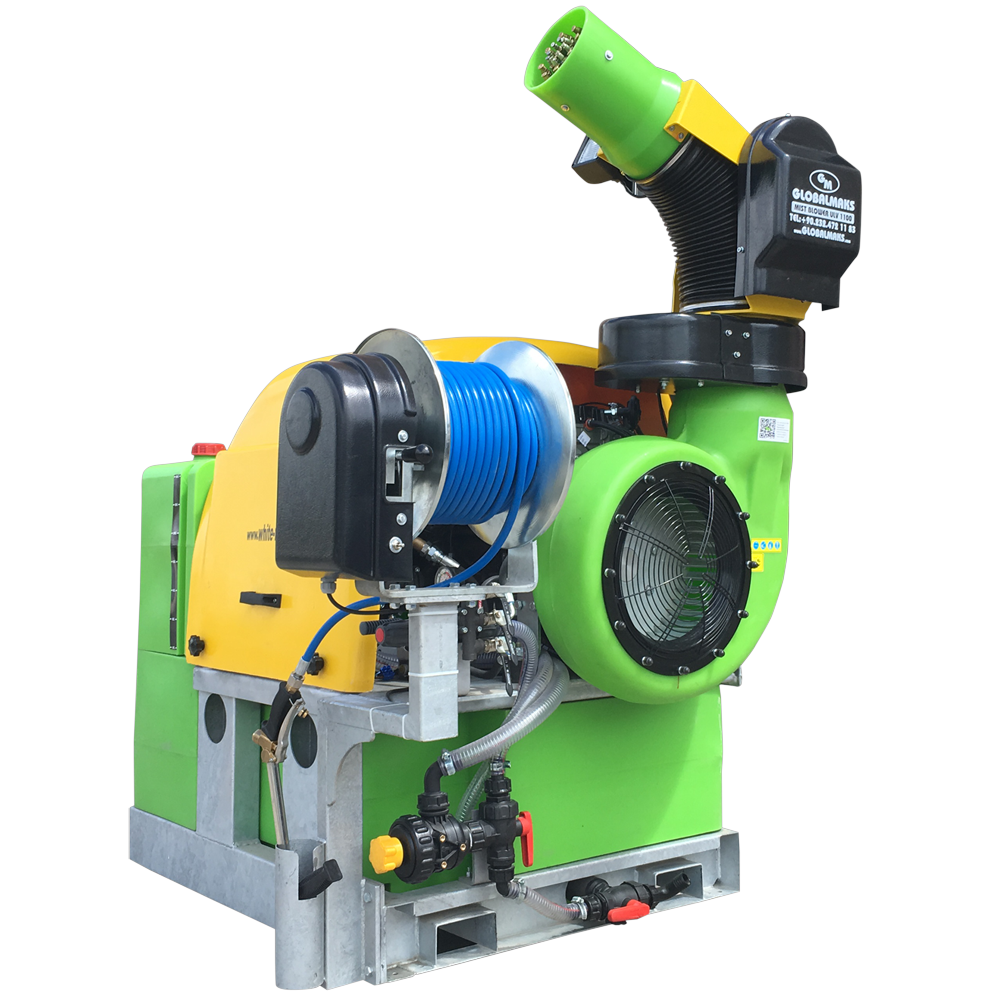
Reviews
There are no reviews yet.